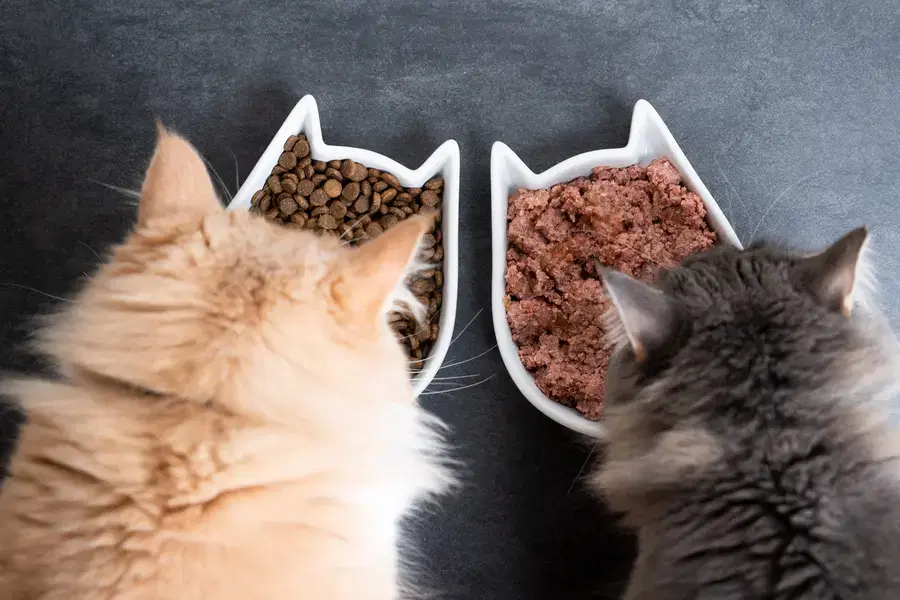Are Preservatives Dangerous to Cats?
While preservative can be harmful to pets, this is not always the case. The risk depends on the kind of preservative, the amount in your pet's food, and how much they are having. But if you're concerned about preservatives in your pet's food, there are preservative-free cat foods available. To understand what exactly preservatives are, the different types, their potential risks, and alternatives, keep reading!
What are Preservatives?
A preservative is a substance or a chemical that is added to products to prolong their shelf life. Preservatives are used in foods, beverages, pharmaceutical drugs, paints, biological samples, cosmetics, and even wood. Their primary function is to prevent decomposition caused by microbial growth or undesirable chemical changes. Preservatives can be natural or synthetic; for example vinegar, salt, sugar, and certain spices have been used for centuries to preserve food.
Preservatives in Cat Food
Both synthetic and natural preservatives can be added to cat food.1
Synthetic preservatives - Butylated hydroxytoluene (BHT) and butylated hydroxyanisole (BHA) are the most common two synthetic preservatives that are added to cat food. BHA is a synthetic antioxidant that helps prevent the oxidation of fats in cat food. BHT is a synthetic antioxidant that is used to prevent the rancidity of fats and oils in cat food. Ascorbic acid and Ethoxyquin are two more preservatives commonly used in pet food.
Natural Preservatives – Preservatives derived from natural sources are often used to prevent oxidation and inhibit the growth of bacteria and mold. The common ones include –
Vitamin E (a.k.a tocopherols): Vitamin E is a natural antioxidant that helps prevent the oxidation of fats and oils in cat food.
Vitamin C (a.k.a ascorbic acid): Ascorbic acid acts as an antioxidant and helps maintain the freshness of cat food.
Vinegar and citric acid are also used as natural options for preservation in cat food.
Benefits of Preservative Use
Preservatives do serve an important purpose when it comes to cat food. The benefits of the same can include –
Increased Shelf Life: They help maintain the freshness of cat food by preventing spoilage, rancidity, and microbial growth. This helps reduce the risk of foodborne illnesses in cats.
Nutrition Preservation: The nutritional value of essential nutrients, including vitamins, minerals, and other dietary components can be preserved using these elements.
Convenience and Accessibility: Prolonging shelf life makes it easier for pet parents to store cat food, especially dry cat foods.
Reduce Waste: Preservatives help minimize the need for frequent disposal of expired or spoiled food, promoting sustainability and responsible consumption.
Spoiled food can lead to food poisoning to your cat. Adding preservatives helps to avoid this.2
Are Preservatives Safe for Cats?
Preservatives are usually safe for your cats as they are monitored by governing bodies. However, there are always a few risks when adding synthetic preservatives into cat foods. The risks can include -
Allergic Reactions: Cats with allergies can develop reactions in the form of skin rashes, itching, gastrointestinal upset, and other symptoms. Learn more about skin conditions in cats.
Gastrointestinal Distress: BHA (butylated hydroxyanisole) and BHT (butylated hydroxytoluene) have been known to cause issues in some cats, including vomiting, diarrhea, and abdominal discomfort.
Long-Term Health Concerns: Currently, there is not much scientific research that has been done on the long-term side effects of preservatives in pet food but some studies have shown that prolonged exposure to certain preservatives may be linked to health issues such as cancer, organ damage, and immune system disorders in pets.
Sensitivities and Intolerances: Some cats may be more sensitive to synthetic preservatives and may show symptoms of discomfort.
Hyperactivity and Behavioral Changes: Some cases of hyperactivity and behavioural changes have also been reported due to prolonged use of preservatives.
Due to these findings, many pet food manufacturers have moved toward using more "natural" preservatives, such as Vitamin C and E.
Regulations on Preservatives in Pet Food
The safety of preservatives in cat food is carefully evaluated and regulated by government agencies such as the Food and Drug Administration (FDA) and the Association of American Feed Control Officials (AAFCO). Cat food manufacturers are required to list preservatives on product labels, allowing pet owners to make informed choices about the products they purchase for their pets.
Alternatives to Artificial Alternatives
The natural preservatives are not known to have many side effects on a cat’s digestive system.3 Apart from Vitamin C and E, two more natural preservatives often used in cat foods are-
Tocopherols: These are heat-stable antioxidants used to prevent the rancidity of fats in pet food and oils. Companies can use these natural preservatives up to a 0.06% concentration.
Rosemary extract: This plant-based alternative prevents the oxidation of fat in pet food and meat. It also serves as an effective measure against bacteria growth.
Conclusion
While preservatives offer multiple benefits to pets and pet owners, they come with their own risks, especially when they are synthetic. As a responsible and loving pet parent, we would suggest you to check the ingredients of any cat food thoroughly to help avoid synthetic preservatives when possible.
Quick tip – While you are going through the ingredient list, also check for meat by-products, corn meal, and carbohydrate fillers. These ingredients can also pose risks to your pet.4
"Preservatives Used in Cat Food," Live Journal, https://petsguide.livejournal.com/1074180.html, Mar. 26, 2021.
"Additives in Cat & Dog Food," UK Pet Food, https://www.ukpetfood.org/resource/additives-factsheet.html, Oct. 26, 2022.
"'Preservative Free' Pet Food?" Cummings School of Veterinary Medicine, https://vetnutrition.tufts.edu/2022/09/preservative-free-pet-food, Sep. 19, 2022.
"Cat Food Ingredients to Avoid," The Spruce Pets, https://www.thesprucepets.com/ingredients-to-avoid-554367, Jan. 6, 2022.
The information presented in this article is for educational and informational purposes only and does not constitute or substitute for the advice of your veterinarian.
